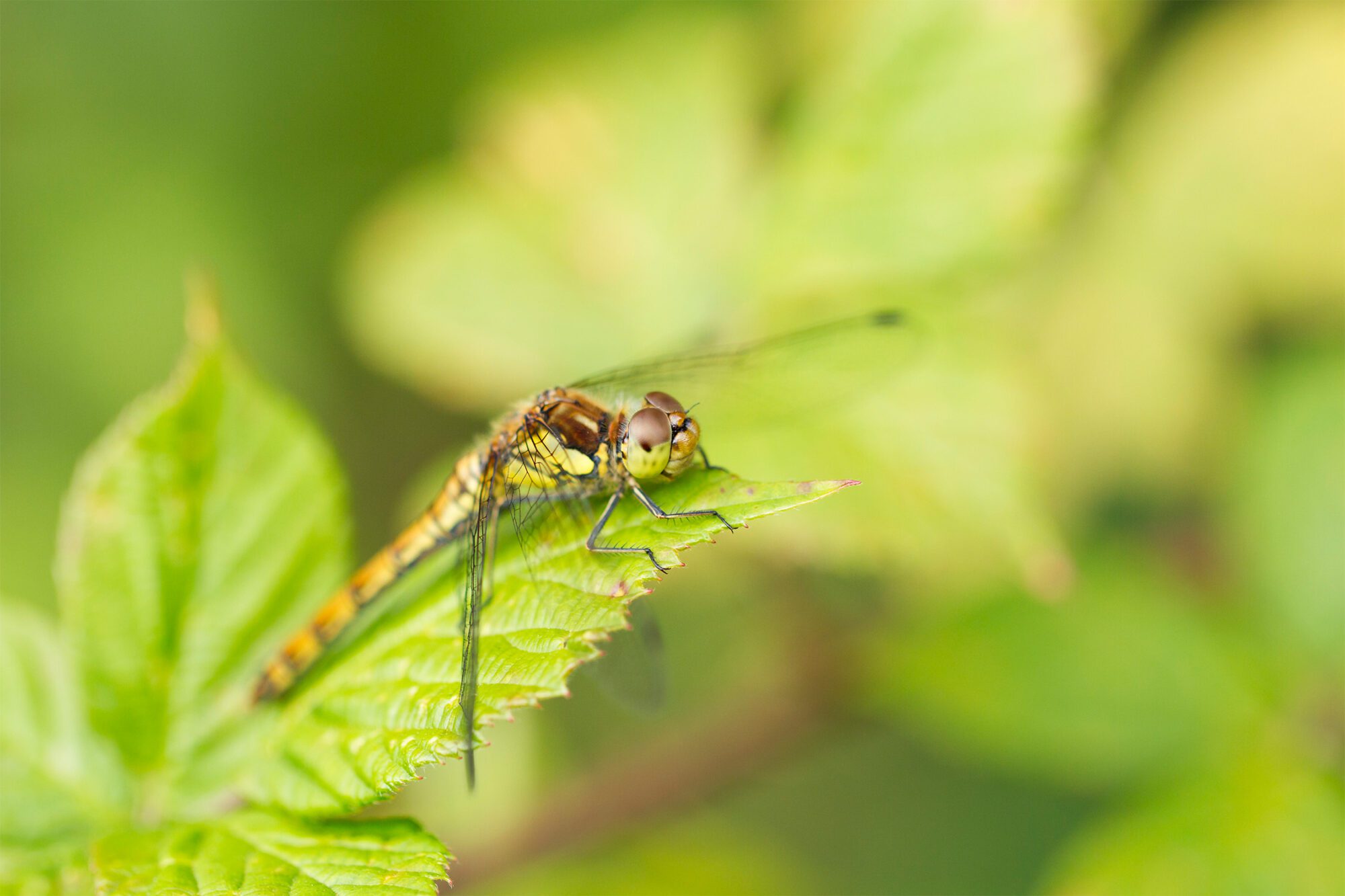The Return Of Macro Photography
It’s been a few weeks since my last blog post. I wanted to wait until I had something a little more special to share with you. In this post I revisit macro photography, something I’ve neglected as of late. For a long time now I’ve done nothing but landscape photography. This summer I wanted to change that. Grab a brew, I hope this delivers!
So those of you who read my previous blog post will know that I’m not a big fan of summer. Summer is a challenging season for me personally and to be honest, I usually lose all interest in photography and sulk the days away until Autumn. This year, I’ve done things a little different. I have set myself the goal of getting out there and stepping outside of my comfort zone and you know what, it’s been great!
Okay so I haven’t been out into the fells and probably won’t do now until Autumn (the exception being for heather season) which means I’ve had a nice break from the wide angle vista shots. Instead, I decided to blow the dust and cobwebs from my 100mm macro lens and my god have I missed using this lens. I first purchased the lens several years ago whilst I was in university. Not long after buying the lens did I realise how addictive the world of macro photography was. The level of detail you begin to notice that wasn’t detectable by eye is unreal. Day by day I began to seek out new opportunities for my new lens, until I discovered the world of insects. This was a whole new interesting world that tested and rewarded patience and persistence.
Below is one of the first shots I ever captured with my macro lens and to this day it’s still one of my favourites! Revisiting this shot in my archives gave me the motivation to take on a new project this summer and keep me shooting.
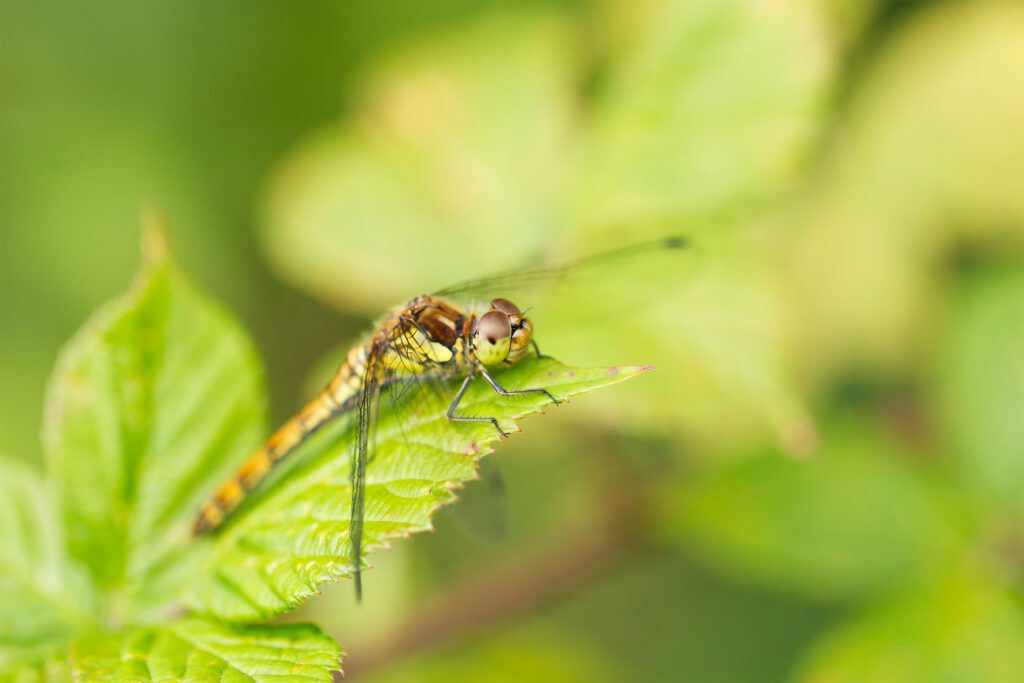
A common darter resting on a bramble leaf. Canon 100mm Macro F2.8L, 1/640, F2.8, ISO 100
Macro Photography, The Focus For Summer 2023
So I had rediscovered my love for macro photography, now all I needed was a subject. Fortunately, I’m lucky enough to have a nature reserve nearby and this was the perfect location! Funnily enough, I used this location to try and complete a ‘Challenge Me’ I was set by one of my best friends over the pond. She set me a challenge of photographing a butterfly cocoon at various stages which I’ve yet to achieve but I haven’t given up yet!
Quick plug, if you would like to set me a challenge, you can do so here. If your challenge is within reason and accessible to me I will give it my best shot (pun intended) and post a write-up with results here in my blog.
Before I dive into the progress to date, I’ll talk you through my plan for the project. My goal is to creatively photograph the worlds lesser seen. Those of us who enjoy hiking, walking trails, even walking your dogs around the local park, we all do it. Each time we’re out we walk past countless habitats of grasses, brambles, nettles and so on. How many of you stop, I mean really stop and take a few minutes to take a proper look at these environments? I didn’t until recently and wow, it’s unbelievable what you notice when you slow down and take a closer look. This formed the basis for my mini-project and it has been my focus over the past few weeks. With that said, I’ll walk you through my progress to date.
The Progress So Far
During the first week, I made a few trips to the reserve. My goal for the week wasn’t really focussed on photography. Instead, I wanted to focus on getting out and seeing what was out there. Also, I wanted to see whether or not influences such as weather had an impact on what I saw. Each trip I picked out small areas and spent an hour or so scouting each area for any signs of interest. I started to get a good idea of what was out there. For the rest of the week, I returned at different times of day to see if this had any impact on what I saw. I also visited in different weathers, again to see what impact this had. First week results overall, I’d seen a lot of ladybird larvae, quite a few damselflies and quite a few different species of butterfly (commas and common blues for the most part) but no dragonflies as of yet.
By the end of the first week, I’d found a great little spot neat the back of the reserve that seemed to be consistent. It had a range of plant life and colours that would provide nice photogenic elements within any potential photograph. I was ready to break out the camera!
The following week I headed back to the reserve around 6pm. It was a clear blue sky at least up until the point I arrived! Earlier in the day we had a pretty good thunderstorm that was much needed after what felt like an absolute eternity without any rain. Pretty sure I’ve never experienced a June as dry as we had, maybe that’s just me exaggerating! Pulling up into the carpark, I jumped out the car and headed through the reserve, getting absolutely feasted on by plagues of mosquitos in the process. They never usually bother me but on this occasion there was so many thanks to the humidity and it was unbearable! I caved and had to throw on the mosquito net to save some of my precious blood.
I got to the area of the reserve I had scouted out stopped and just stood still for a few minutes whilst scanning around. Pretty much immediately I saw a few different species of damselflies. They’re such a nice insect to photograph, especially with the macro lens. I find if you approach quite slowly, you can get really close and they don’t really move unless you make sudden movements. Of the bunch, a small blue tailed damselfly caught my eye. It was rested up on the tip of a fern leaf (or frond for the technical name). I got into position and fixed up my settings to cater with my 100mm macro attached. There was a slight breeze so I opted for ISO 400 to bump up the shutter speed and underexposed by 1 and a bit stops to counter the still fairly harsh direct light on the scene.
Just as I was about the take the shot, the blue tail contracted his abdomen and curled his tail. It’s so cool how they’re able to do that! I took a few shots just to make sure I bagged a pin-sharp shot. I looked back at the shot on the back of my camera, I loved the way the curved tail almost mimicked the curve of the fern the blue tail was perched on. Not long after this I heard a pretty violent rumble in the distance, I looked behind me I saw a second storm rolling in pretty quickly. That was definitively my queue to leave. Not wanting to get caught out I packed the camera away and legged it back through the reserve to my car. Timing was impeccable, I’d say literally a few minutes after I’d got back into my car the heavens opened and torrential rain flooded the area! It was much needed though, up until then most of the area was a tinderbox. Anyway, here’s the blue tail – not overly happy with the light but I do like the shot itself!
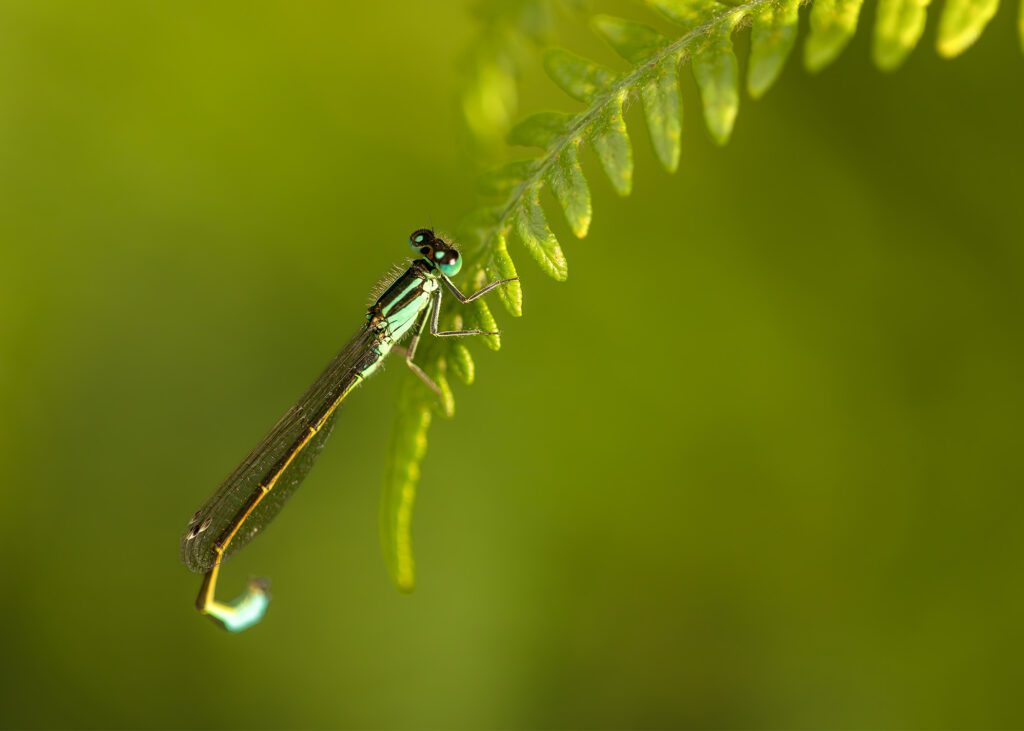
Blue tailed damselfly perched on a fern leaf. Canon 100mm F2.8L, 1/800, F2.8, ISO 400, -1 2/3
Fast forward a few days, I’d been backward and forward to the reserve quite a bit – a quick bike ride away gives me no excuse to not get out really! I still hadn’t seen any dragonflies, kind of unusual but I put it down to the weird weather we had throughout June. This time around, it was raining and I decided to take a walk around the local pond. I’d noticed a few days prior that the water lilies had begun to flower and they looked great! It was still raining but I had plenty of cover from the dense trees. surrounding the pond and my waterproofs. After a couple of laps I found a nice section of the pond quite close to the bank, a flowering lily not too far out surrounded by a handful of larger pads and 4 distinct smaller pads that were much lighter in colour. It was still raining so I took a few shots trying to capture water droplets hitting the water around the lilies, I wasn’t a fan so went back to waiting for a gap in the rain. Eventually the rain stopped. It was still overcast and looked ready to unload the next batch of rain so I grabbed the camera out of my bag quickly. Looking at the water I also dug out the polariser an fixed it to the lens – the scene was flooded with harsh reflections and I wanted to remove as much of these as possible. I also wanted to increase the contrast between the green lily pads and the colour of the water. I grabbed a couple of shots, again just to make sure I had one with relatively few ripples in the water – the wind was doing its best to throw me curve balls. Here’s the finished result which pretty much brings us up to date.
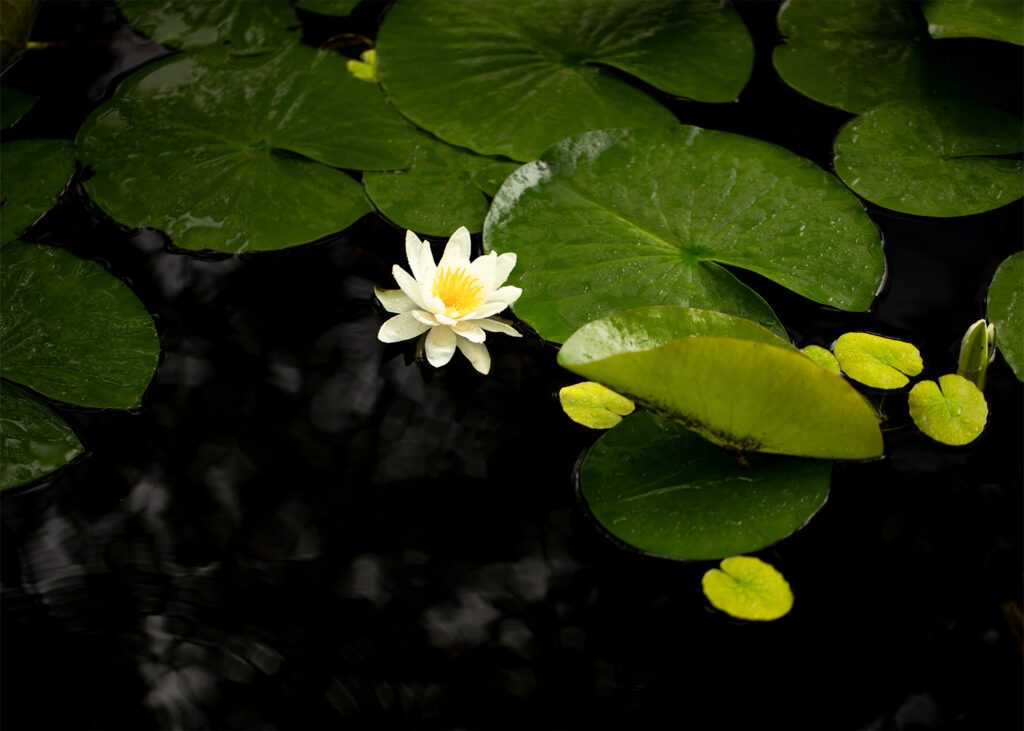
Flowering water lily. 100mm, F4, ISO 400, 1/200
Finishing Comments
I’ve taken plenty more shots but nothing to write about really, mostly work in progress. A couple of interesting finds which until recently I never knew! Throughout my trips backwards and forwards I’d noticed quite a few small weird looking bugs with 6 legs and orange bands across their backs. I took a picture on my phone and did a Google image search and discovered they were actually ladybird larvae. So cool! Up until this point I had no idea that ladybirds had a diverse lifecycle. I always assumed ladybirds were just born as ladybirds, who knew! A few days back, armed with my new found knowledge I also came across a ladybird pupa. It looks so strange but compared to the larvae, it looks more like you would expect a ladybird to look like at least. It’s honestly amazing, prime example of something I’ve probably walked past hundreds of times before but never noticed. I’ll put the image below just because I thought it was a cool find!
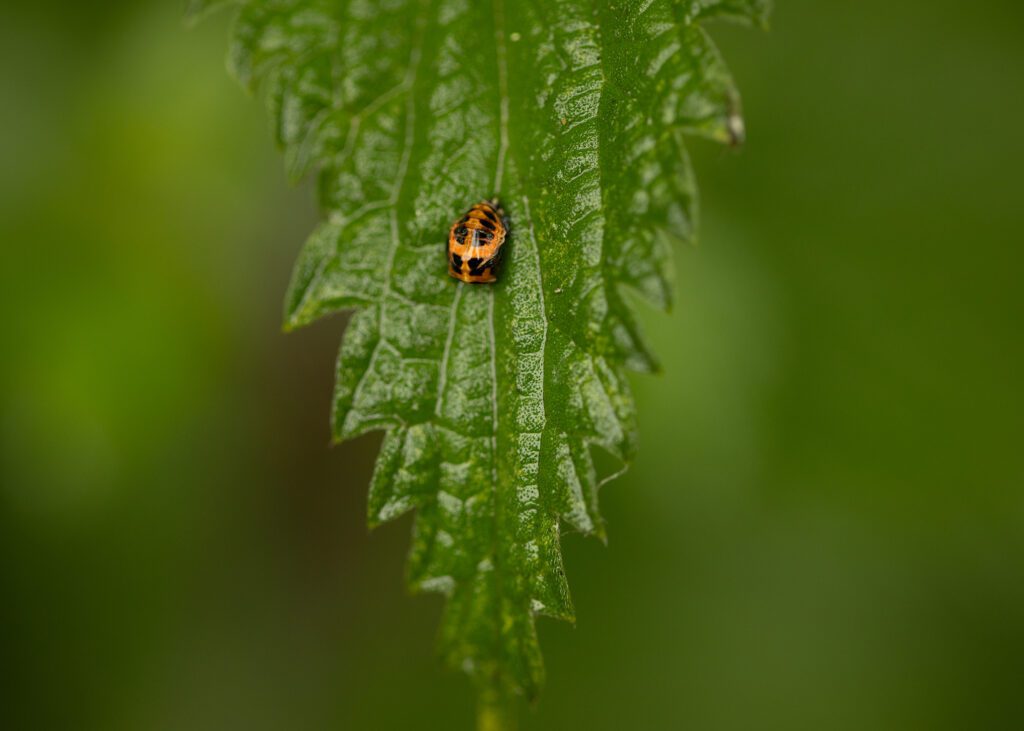
Ladybird pupa on a nettle leaf. Canon 100mm F2.8L, F2.8, ISO 400, 1/125
I didn’t manage to get a high resolution shot of the larvae, they move so quickly but if I’ve sparked any interest, give it a quick Google. Next time you’re outside whether it’s walking the dog through the woods or just enjoying a good trail, take a few minutes and have a closer look amongst the brambles, nettles and grasses. You’ll be surprised at how much life these areas support!
That’s it from me for now, I think I’ve waffled on long enough now, sorry! Hopefully I’ll have some great content for the next post. Until then, I hope that I’ve motivated you to get outside and take a closer look at what might otherwise be an everyday scene!
I would love to hear your feedback on this post, please leave a comment below and let me know what you think. Also, I’d love to hear if you knew whether or not ladybirds had a lifecycle! It would be interesting to know how many of you did or did not.

